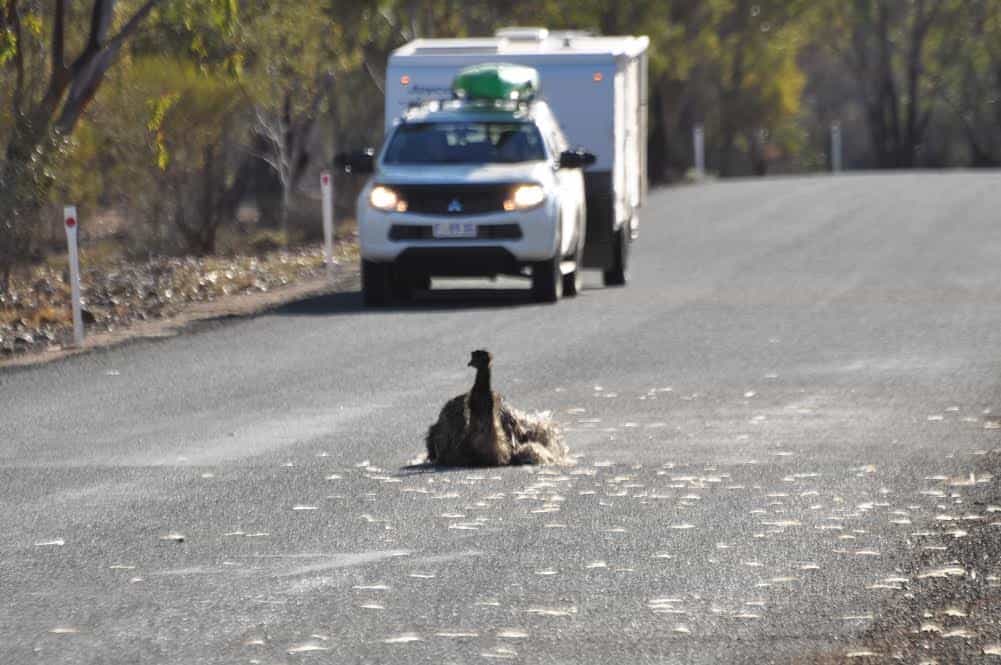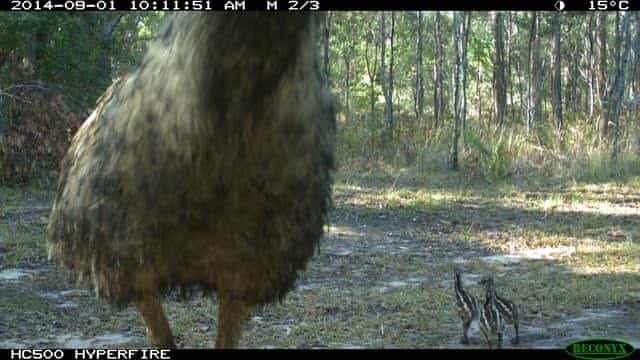Solving the case of the disappearing coastal emu

IF YOU INVESTIGATE historical records from when settlers arrived, expanded out from Sydney, and started using these big birds as a food source, they record emus as plentiful in Tasmania and along mainland Australia’s east coast.
They also show that within 100 years of settlement, the Tasmanian population had disappeared and the north coast communities were in rapid decline.
Fast forward to modern day and, sadly, only one population persists, along a small 100km stretch of the NSW north coast, which prompted the NSW Government, in 2002, to recognise the remaining coastal emus as an endangered population. In contrast, their inland cousins remain common.

The range of the endangered coastal emu population. (Image credit: Coastal Emu Alliance)
Why is the coastal emu population still declining?
The coastal emu was regularly spotted until the 1980s. However, community surveys have detected a rapid decline in numbers since the 2000s. The 2015 and 2016 surveys showed numbers have fallen from 100 emus to less than 50.
What has driven this decline? Known factors include native vegetation clearing and vehicle strike. The emu’s natural long-ranging movements are also impeded by barriers such as fences, highway upgrades and agricultural and urban development.
“Some of the other threats include predation by introduced pigs, dogs and foxes on both eggs and chicks,” says Mark Graham, an ecologist who lives in the region.
Inappropriate fire regimes and landscape-level vegetation change from open woodlands to thick, scrubby, heathy vegetation are other contributing factors.
Losing the coastal emu is likely to impact our coastal forests
Why should we care? According to Julia Ryeland, PhD student at the University of Western Sydney, the coastal population is genetically distinct from the inland emu. “It looks they have been distinct for some time, likely because of geographic barriers like the Great Dividing Range,” Julia says.
The coastal emu is also a keystone species.
“The coastal emu is a very important seed disperser in coastal habitats on the North Coast,” Mark says. “It moves large distances and assists in the dispersal and the regeneration of native species.”
There are other native species that “do similar things but just not in the same quantity and same distances,” says Julia.
One study shows one emu scat can contain 1000 seeds and emus move seeds distances of up to 50km.
If the coastal emu is lost from the ecosystem this might reduce species diversity and populations of other species that depend on the plants that it spreads.

An emu struck by a vehicle. (Image credit: Jan Taylor)
A community approach to solving the case of the disappearing emu population
For the coastal emu to persist, local communities need to help crack the case of their decline.
Owners of the land where emus roam are encouraged to install emu friendly fences. David Wailes, a property owner, has done this. “All you need to do is add another star picket,” he says. “It costs a couple of dollars and took me a matter of 30 mins.”
Communities where the coastal emus remain are delivering projects funded by the NSW Environmental Trust (the Trust). The projects are improving emu habitat, removing barriers to movement, and training landholders to find emus, wild dogs and feral pigs through remote camera trapping.
With money from the Trust, the Clarence Valley Council is getting individuals to play the role of emu detective and report sightings via an online register.
The drastic measure of a breeding program for the remaining coastal emus is proposed by the Coastal Emu Alliance – made up of government, landowners, environment groups and the broader community of the NSW North Coast. “We would love to get a captive population of coastal birds and try to preserve those genetics, with a view of building up enough numbers to release birds,” says Josh Keating, the Coastal Emu Alliance Coordinator.
Sniffing out emu nests and chicks
The coastal emu is surprisingly elusive. “You don’t find nests very often in the wild,” Julia says. “They’re a tricky species to study.”
To find nests, a detective of the canine kind was funded by the Saving our Species Program, under the auspices of the NSW Department of Planning, Industry and Environment.
Penny the Springer Spaniel has been sniffing out emu feathers, tracks, scats and other evidence.
Remote cameras were then set up by the Coastal Emu Alliance to detect emus moving through the landscape. “The idea is to hopefully pinpoint or zoom into where they may be nesting,” says Josh.
Julia is investigating how many chicks need to survive to sub-adulthood to have a stable population. “It looks like you need only a few,” Julia says. “Once they are adults, they’re relatively safe.”

(Image credit: Jan Taylor)
A bush corridor for the emus
If a breeding program is to go ahead there needs to be good habitat for any emus that are released.
The coastal emu has, and still is being used as a flagship species to help conserve a large bush corridor across the Clarence-Richmond lowlands, recognised internationally as a biodiversity hotspot.
The Coastal Emu Alliance is working with landholders to deliver best-practice environmental management of their land. This is so the coastal emu corridor remains in good condition.
Is there hope for the coastal emu?
Endangered species with numbers as low as the coastal emu, such as the California condor and Przewalski’s horse have increased in numbers with concerted effort. To solve this case there will need to be funding and support from government, individuals and local communities alike.
How you can help save the coastal emu
If you want to help you can:
- Report coastal emu sightings to the Coastal Emu Register
- Drive slowly in areas of known emu habitat
- If walking in known emu habitat, keep your dog on a leash.




